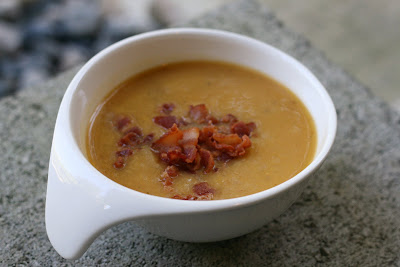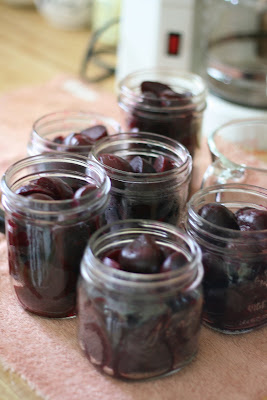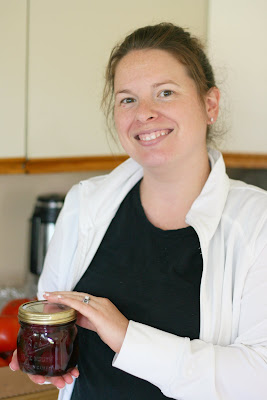 Kits Beach, Vancouver
Kits Beach, VancouverA few months ago, I posted about
what it means to be local and just last week I posted some
resources for locally and humanely raised animal products. I think I skipped a step in there though, so now it is time to talk about how to make the switch to locally grown and produced products.
Get Local BC suggests you start small. Begin with one or two of the foods you buy the most, rather then an entire food group. Find local sources for the products and compare prices to find the best supplier for your needs and wallet. Once you have made the switch to one or two local items, do the same with a few more items until you have local sources for much of your fresh food supply.
 Granville Island Market, Vancouver
Granville Island Market, VancouverOther tips to help you shop and eat local:
- First, define what "local" means to you. Revisit my post
about what it means to be local. Do you want products produced and growth within Canada, within your Province, or within your regional area?
- Avoid large, chain grocery stores. These grocery stores carry very little local produce (if any at all), and often what they do carry is not as fresh as you would get elsewhere. There are some exceptions, of course so check the produce department of your local grocery store to see what locally grown products they offer. The best alternative is to shop your local, independent grocer or your local organic/natural foods grocer.
- Learn what products are "in season" each month, before you go shopping. Not everything is available year round. Eating local means eating in season. Check
Get Local BC's Seasonal Chart or my posts on
Spring,
Summer,
Fall and
Winter foods. (Lists applicable to BC and Pacific North West region only. If you live in other area of the country, go to Google to find an "in season" chart for your area.)
- When starting the switch to local, don't worry about organic. If you can find local AND organic produce, GREAT! If not, think about what is more important to you, based on your food philosophies. Some people feel better about eating organic. Some feel better about eating local. Again, both would be ideal but sometimes it is not possible. I tend to buy local over organic, especially in the Summer during market season. Come fall & winter I tend to buy organic in the stores. Check my post about
whether or not to buy organic before you make your choices.

- In the Spring and Summer, visit your community
Farmer's Market. The produce is picked at the peak of freshness and brought to the market for you to buy, direct from the grower. Roadside farm stands are also a great choice!
- In the off season, visit independent produce markets, like
Kins Farm Market or sign up for a home delivery service like
Spud.ca or
Organics@Home.
- If you live in British Columbia, buy
Hot House. BC Hot House is 100% owned by local growers. BC Hot House tomatoes, cucumbers and bell peppers are sold around the world. We are lucky enough to have them based and grown, right in our backyard, with farms in Surrey, Abbotsford and Ladner. Just watch out for their other label MX Hot House. Those products are grown in Mexico during the winter months when there isn't enough light to adequately grow greenhouse produce here.
- Read labels and signs to know where your food is coming from. Not all produce at your local, independent grocer or produce markets is local. Kins carries a huge selection of produce from California. Just the other day I bought Californian plums because I wasn't paying attention. If you aren't sure, ask questions. You have a right to know where your food is coming from.
- Plant your own garden and grow the items you tend to purchase the most. If you don't have space for an outdoor garden, consider a container garden. This year I planted a large container herb garden, container lettuce and container tomatoes. Several cities now have community gardens as well.

- Preserve the Bounty! This summer I participated in The Nourished Kitchen's Preserve the Bounty challenge and preserved over 12 litres of in season fruit and produce for use in the winter months. I bought a food dehydrator and dried fresh herbs and in season fruit. Along with canning, drying, fermenting and vinegar preserving, you can also freeze some foods for use during the off season.
- If you can afford it and have the freezer space, buy your meat products in bulk. Buy a half or a quarter of a cow direct from the farmer. You will save money and time as you won't need to return to the farm or other vendors every few weeks or months to re-stock. With local beef and poultry readily stocked in your freezer, you won't be tempted to buy lesser quality meat of unknown origin from the grocery store. (
Ann Marie at Cheeseslave says it takes 7 cubic feet of freezer space to store half a cow.)
- Adjust your cooking focus to be in line with seasonal food. In the summer, cook with beets, corn, green beans, zucchini and berries. In the Fall, try Brussels sprouts, parsnip, cauliflower and pears. In Winter, stick with apples, carrots, onions, butternut and other winter squashes. In the Spring enjoy asparagus, rhubarb and
BC Spot Prawns.
- Realize that buying local doesn't mean giving up foods you love. Certain foods like citrus fruit, are not available at any time in British Columbia.
Buy local when you have the choice but don't feel like you have to give up locally unavailable foods. Instead, buy from your local produce market to ensure you are getting the freshest produce possible and buy organic when possible. For pantry staples like soy sauce, sugar, coffee, rice, olive oil etc, buy high quality, un-refined and organic when possible.
For more information:
Get Local BC has produced a
directory, mainly aimed at residents in the City of Vancouver. It has lots of good resources about where to shop for local products.
Eat Wild Canada has an extensive list of sources for grass-fed beef and other humanely raised animal products.
Check my post about local vendors and resources
for locally and humanely raised animal products, such as dairy, meat, seafood and poultry.
This post is part of Monday Mania at The Healthy Home Economist

















































